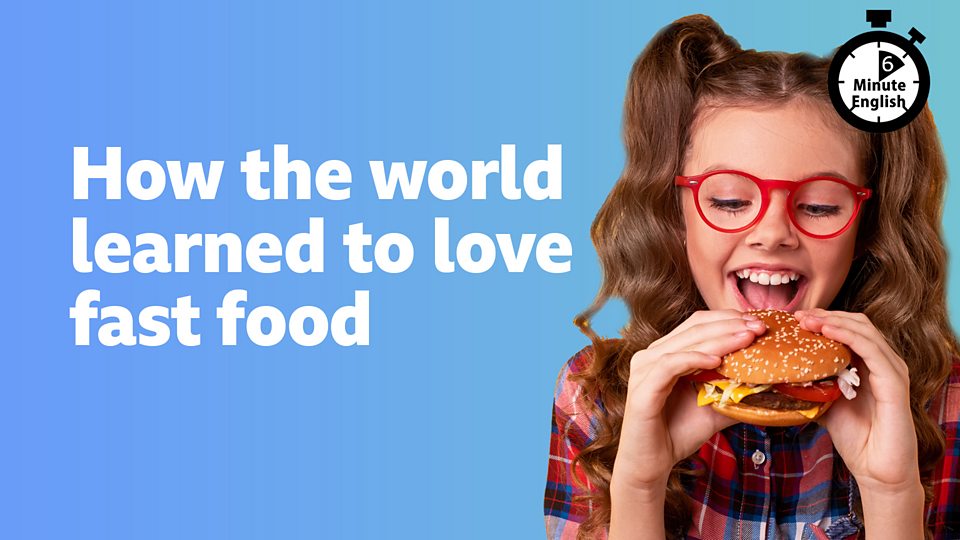BBC Learning English 문법강좌 How the world learned to love fast food - 영국 BBC 6분 영어 문법
이번주 BBC Learning English - 6 Minute English가 다룬 문법 관련 이슈 는 관계대명사(7), that(3), 명사(2), 문장형식: 4형식(2) 등이였습니다. 그 외에 문장형식: 5형식, 법조동사, 수동태, 여러낱말 전치사, 전치사, 전치사(명사)구, 접속사, 형용사, 문장부호, 관계부사, 낱말·구·마디, 동사: 시제·모습(tense-aspect), 마디[節, clause] 등이 각각 1 건씩 다루어졌습니다.

[본문] [07] Erm, not really, No. I think sometimes it can be quite convenient, obviously because it's quick, but not really.
Erm, not really, No. I think {that} sometimes it can be quite convenient, obviously because it's quick, but not really.
[설명] 'I think' 뒤에 명사절을 이끄는 접속사 that이 생략되었습니다. 절의 문장성분은 목적어입니다.
[본문] [08] Well, whatever you think about them, fast food brands like KFC, Domino's and, of course the big one, McDonald's, are incredibly successful.
[설명] whatever가 접속사로 「어떤 …일지라도, 어떤 …이든」의 의미를 갖는 부사절을 인도합니다.
[본문] [18] Listen as Adam Chandler, author of the book Drive-Thru Dreams, which traces the history of American fast food, tells BBC World Service programme, The Food Chain, how it all got started:
[설명] ⑴ 『which traces ~』의 which는 선행(명)사에 정보를 보태는 비제한용법의 관계대명사입니다. 선행(명)사는 'the book Drive-Thru Dreams'입니다. 비한정용법은 쉼표로 둘러싼 삽입절의 꼴을 갖습니다.
⑵ 「the book」과 「Drive-Thru Dreams」는 동격입니다.
⑶ 「got started」 get 수동태 글짜임입니다.
[참조 Blog 링크]☞ 관계대명사의 비제한적용법(Non-restrictive use, Non defining relative clauses)
[참조 링크]☞ What are embedded clauses?
[본문] [19] At the heart of the story of fast food is a very 'anyone can do this' sense.
[설명] ⑴ 「At the heart of ~」는 복합전치사입니다.
⑵ 『At the heart of the story of fast food』는 명사적 용법으로 사용되는 전치사명사구입니다. 문장성분은 주어입니다.
⑶ 『very 'anyone can ~』의 very는 형용사입니다. very가 형용사를 쓰일 때는 앞에서 명사를 꾸미는 한정적 쓰입법으로만 씁니다.
[본문] [22] It made opportunity very, very easy in a time when that was a new part of the American experience.
[설명] ⑴ 『It made opportunity very ~』는 make 5형식 글짜임입니다. 목적어가 opportunity, 목적어보충·어[補語, complement]가 'very, very easy'입니다.
⑵ 『when that was a new ~』의 when은 한정용법의 관계부사입니다. 선행(명)사는 「a time」입니다.
[본문] [25] When Adam says that this lies at the heart of the story, he means it's the most important part of the story.
[설명] ⑴ 『that this lies ~』는 접속사 that이 이끄는 명사절입니다. 절의 문장성분은 목적어입니다.
⑵ 'he means' 뒤에 명사절을 이끄는 접속사 that이 간추려졌습니다. that절의 문장성분은 목적어입니다.
[본문] [26] In the 1950s, when the famous brands we know today were just beginning, anyone with a can-do attitude could sell fast food.
In the 1950s, when the famous brands {which/that} we know today were just beginning, anyone with a can-do attitude could sell fast food.
[설명] 선행(명)사 'the famous brands' 뒤에 목적격 관계대명사 which 또는 that이 간추려져 빠져 있습니다.
[본문] [27] A can-do attitude describes someone who is confident and determined to fix problems and achieve results.
[설명] 『who is confident ~』의 who는 한정용법 주격의 관계대명사입니다. 선행(명)사는 someone입니다.
[본문] [28] Which is exactly what happened at successful restaurants like Kentucky Fried Chicken and McDonald's.
[설명] 『what happened at ~』는 what 주격 관계대명사절입니다. 절의 문장성분은 보충·어[補語, complement]입니다.
이 포스팅은 쿠팡 파트너스 활동의 일환으로, 이에 따른 일정액의 수수료를 제공받습니다.
[본문] [29] For many, these fast food brands symbolised The American dream - the idea that anyone in the United States can achieve success through hard work and determination.
[설명] ⑴ 『For many』의 many는 명사로 '많은 사람들'이란 뜻입니다.
⑵ 『that anyone in the ~』 절의 접속사 that은 동격의 that입니다. 'the idea'와 that 명사절은 동격관계에 있습니다.
[본문] [32] But not every country opened its arms in welcome - the tiny island of Iceland for one.
[설명] 「the tiny island」와 「Iceland」는 동격관계입니다. 이를 동격의 of라고 합니다. '~라는, ~와(과) 같은'으로 해석합니다.
★ for one 그 중하나는, 예를 들면
[참조 링크]☞ 해석의 기술 for 독해, 동격 명사 + of ~ing
[본문] [33] Andie Sophia Fontaine, who used to work in McDonald's, now edits The Iceland Review.
[설명] ⑴ 『who used to work ~』의 who는 선행(명)사 'Andie Sophia Fontaine'의 속뜻을 더해 주는 비제한용법의 관계대명사입니다. 흔히 콤마로 둘러싸인 삽입절의 꼴을 갖습니다.
⑵ (서)법조동사 「used to」는 비교적 긴 기간에 걸친 과거의 상습적인 동작이나 상태를 나타냅니다.
[본문] [37] Yeah, so McDonald's - they struggled to try to maintain a market.
[설명] 대시(줄표)는 동격 관계를 나타냅니다. 「McDonald's」와 「they」는 동격입니다. 대시가 '(관계)대명사+be동사'의 기능을 합니다.
[본문] [39] Iceland already had a long-standing tradition of eating burgers - a tradition that had existed for a long time.
[설명] ⑴ 『that had existed for ~』의 that은 관계대명사입니다. 격은 주격이고, 선행(명)사는 'a tradition'입니다.
⑵ 『had existed』는 현재-완료 시제-모습[현재 시제+완료 에스펙트(相)]입니다. 현재까지의 '계속되는 상황'을 나타냅니다.
[본문] [42] And the global financial crash of 2008 was the final nail in the coffin, an event which caused the failure of something that had already started to go wrong.
[설명] 『which caused the ~』의 which는 주격의 관계대명사입니다. 선행명사 'an event'의 뜻을 묶어 주는 한정 쓰임법입니다.
[본문] [45] I asked you how many fast food restaurants there are in Britain.
[설명] 이 월(=文章)은 ask가 4형식 글짜임을 만듭니다. 간접목적어는 you, 직접목적어는 how 명사절입니다.
[본문] [46] I asked you if there were 4,000, 42,000 or four million.
[설명] ⑴ 이 월(=文章)은 ask가 4형식 글짜임을 만듭니다. 간접목적어는 you, 직접목적어는 if 명사절입니다.
⑵ 접속사 if가 종속절로 명사절을 이끕니다. 문장성분은 (직접)목적어입니다.
pdf 파일은 이곳을 클릭하세요.
https://softca.tistory.com/3069을 클릭하세요.
이 블로그에는 [BBC 6분 영어와 관련하여 매주 다음과 같은 글들이 게시 됩니다
- 단어공부(금주 대본에 나온 주요 어휘) https://wordstudy.tistory.com/679
- 멀티단어공부(금주 대본에 사용된 멀티단어(구동사, 숙어) 간단 정리) https://softca.tistory.com/3070
- 독해공부(금주 대본의 문장별 해석(직역) 자료) https://softca.tistory.com/3071
- 문장별 문법공부(문장별 문법 설명) 이 글입니다
- 금주의 어휘(금주 대본에 나온 금주의 어휘를 집중적으로 정리한 자료) 이 글의 포스팅 시점에는 아직 작성되지 않았습니다.
- 항목별 문법공부(금주 대본에 나온 문법을 주제별/항목별로 정리한 자료) 이 글의 포스팅 시점에는 아직 작성되지 않았습니다.
- 금주의 구동사(금주 대본에 사용된 구동사 상세 정리) 이 글의 포스팅 시점에는 아직 작성되지 않았습니다.
- 금주의 PDF(금주의 PDF 및 기타 다운로드 파일) https://softca.tistory.com/3069
아래의 이미지를 클릭하시면 PDF로 된 대본(Script)를 다운받을 수 있습니다.
[영어 문장 공부] 자료를 처음 보시는 분은 아래의 링크를 클릭하셔서 「공부법」을 먼저 보시기를 권장 드립니다.
[영어문장공부] 학습법 보기



